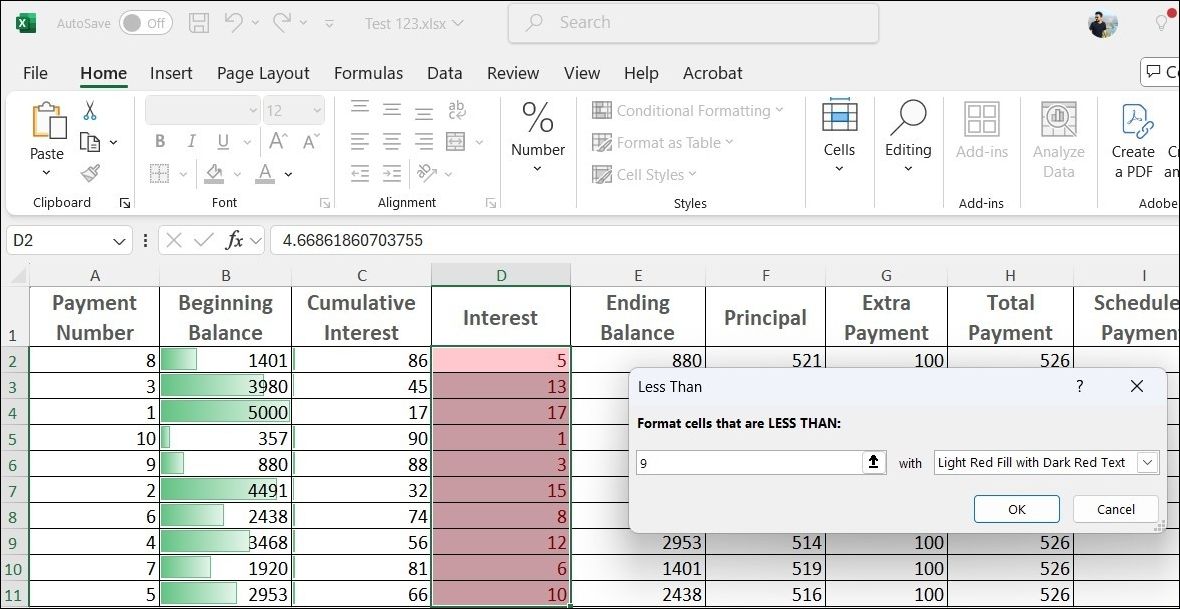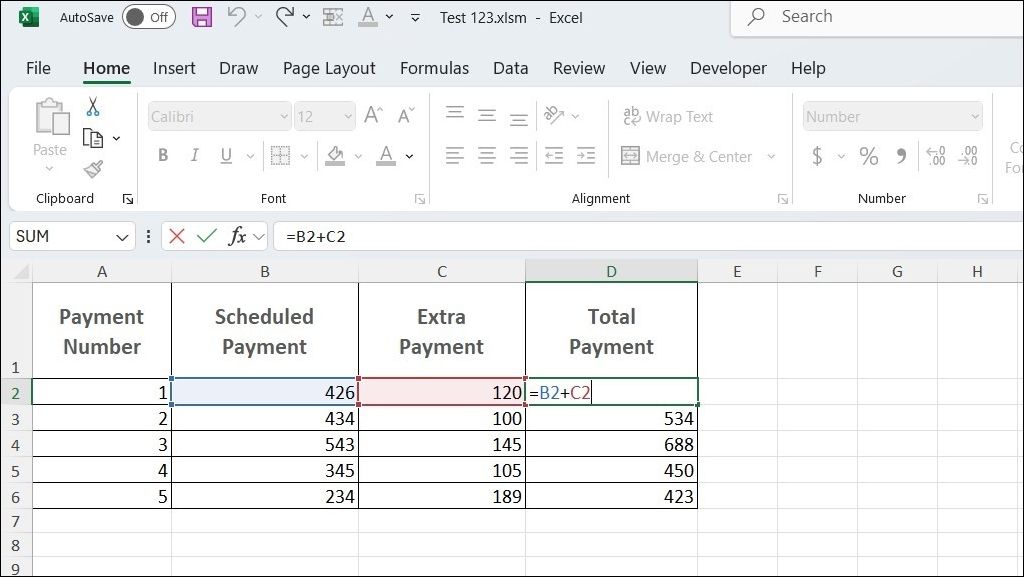I’ve been gradually building up my Excel shortcut knowledge over time, and it has genuinely helped me work with spreadsheets more efficiently. Once you start incorporating shortcuts into your daily workflow, there’s honestly no going back to the old way.
6
Navigation Shortcuts
Help Quickly Move Around Spreadsheets
Moving around large spreadsheets used to feel like a chore until I started using navigation shortcuts. Instead of scrolling endlessly or clicking through countless rows, you can jump to exactly where you need to be.
Arrow keys are essential for basic navigation, but they sometimes stop working properly in Excel. If you’re experiencing this issue, there are ways to fix the arrow keys not working in Excel that can help you get back on track quickly.
|
Action |
Shortcut |
|---|---|
|
Jump to the beginning of the worksheet (A1) |
Ctrl + Home |
|
Jump to the last used cell |
Ctrl + End |
|
Move to the edge of the data in any direction |
Ctrl + Arrow Keys |
|
Go to a specific cell or range |
Ctrl + G or F5 |
|
Move to the beginning of the current row |
Home |
|
Switch between worksheets |
Ctrl + Page Up/Down |
|
Jump to the top of the current column |
Ctrl + Up Arrow |
|
Jump to the bottom of the current column |
Ctrl + Down Arrow |
These shortcuts are handy when working with datasets that span hundreds or thousands of rows. Along with using navigation shortcuts, you can monitor key data points with Excel’s Watch Window while navigating between different sections of your spreadsheet.
The Ctrl + End shortcut deserves special mention as it instantly takes you to the last cell containing data, which is perfect for quickly assessing the size of your dataset.
If Ctrl + End takes you further than expected, you might have invisible formatting in empty cells. Clear the formatting in those areas to fix this behavior.
5
Data Selection Shortcuts
Speed Up Range Selection
Selecting data ranges manually can be tedious, especially when dealing with large datasets. These selection shortcuts eliminate the need to drag your mouse across hundreds of cells.
The shift key becomes your best friend for extending selections. Hold it down while using any navigation shortcut, and you’ll select everything between your starting point and destination.
|
Action |
Shortcut |
|---|---|
|
Select the entire row |
Shift + Space |
|
Select the entire column |
Ctrl + Space |
|
Select the entire worksheet |
Ctrl + A |
|
Select the end of the data in any direction |
Ctrl + Shift + Arrow Keys |
|
Extend the selection of one cell |
Shift + Arrow Keys |
|
Select from the current cell to the beginning |
Ctrl + Shift + Home |
|
Select from the current cell to the end |
Ctrl + Shift + End |
These shortcuts work perfectly when you need to use Excel’s CHOOSE function to select data based on criteria or apply formatting to specific ranges.
When selecting multiple non-adjacent ranges, hold Ctrl while clicking on each additional range. This technique works with both mouse clicks and keyboard shortcuts.
4
Formatting Shortcuts
Make Spreadsheets Look Professional
Well-formatted spreadsheets make a significant difference in how your data is perceived. Basic text formatting shortcuts are worth learning for emphasizing important data, as bold headers and italic notes can change a plain spreadsheet into something that looks professionally designed.
The following formatting shortcuts help you quickly polish your work without needing to look into ribbon menus.
|
Action |
Shortcut |
|---|---|
|
Apply bold formatting |
Ctrl + B |
|
Apply italic formatting |
Ctrl + I |
|
Apply underline formatting |
Ctrl + U |
|
Format as currency |
Ctrl + Shift + $ (Dollar) |
|
Format as percentage |
Ctrl + Shift + % (Percent) |
|
Add borders around the selection |
Ctrl + Shift + & (Ampersand) |
|
Remove borders |
Ctrl + Shift + _ (Underscore) |
|
Open Format Cells dialog |
Ctrl + 1 |
|
Increase font size |
Ctrl + Shift + > (Greater than) |
|
Decrease font size |
Ctrl + Shift + |
|
Copy formatting only |
Alt + Ctrl + C |
|
Paste formatting only |
Alt + Ctrl + V |
The Format Cells dialog Ctrl + 1 is a powerful shortcut, as it gives you access to every formatting option available. This shortcut saves countless clicks when you need precise control over number formats, alignment, or cell appearance.
You can use Alt + Ctrl + C and Alt + Ctrl + V to copy formatting from one cell and apply it to others quickly. This way, you can maintain consistency across your spreadsheet without having to manually adjust each cell.

Related
How to Disable Excel’s Annoying Auto-Formatting
Excel’s auto-formatting has a mind of its own, but you can take back control with a few simple tweaks.
3
Formula Shortcuts
Get More Done
Understanding what Excel formulas are is just the beginning—knowing how to work with them efficiently is where real productivity gains happen.
Working with formulas becomes much faster once you know the right keyboard combinations. These shortcuts eliminate the tedious process of clicking through menus or manually typing repetitive functions.
|
Action |
Shortcut |
|---|---|
|
Insert AutoSum formula |
Alt + = (Equals) |
|
Edit the active cell formula |
F2 |
|
Toggle absolute/relative references |
F4 |
|
Insert current date |
Ctrl + ; (Semicolon) |
|
Insert current time |
Ctrl + Shift + ; (Semicolon) |
|
Calculate all worksheets |
F9 |
|
Show/hide all formulas |
Ctrl + ` (Grave accent) |
|
Fill formula down |
Ctrl + D |
|
Fill in the formula right |
Ctrl + R |
|
Cancel formula entry |
Esc |
The F4 key is useful when building formulas; it cycles through different reference types ($A$1, A$1, $A1, A1) without manual typing. This saves time when creating complex formulas that need mixed references.
If you press Ctrl + ` (grave accent), it toggles to formula view mode. If your spreadsheet suddenly shows formulas instead of values, press this combination again to return to normal view.
2
Data Management Shortcuts
Keep Information Organized
Productive workflows require you to keep your data organized and well-structured. Whether you’re using Excel spreadsheet templates to manage finances or tracking project information, these shortcuts maintain structure efficiently.
These management shortcuts help you sort, filter, and structure information without needing to constantly switch between ribbon tabs.
|
Action |
Shortcut |
|---|---|
|
Apply AutoFilter to the selection |
Ctrl + Shift + L |
|
Open the Find & Replace dialog |
Ctrl + H |
|
Insert a new row above the current one |
Ctrl + Shift + + (Plus) |
|
Insert a new column to the left |
Ctrl + Shift + + (Plus) |
|
Delete selected rows |
Ctrl + – (Minus) |
|
Delete selected columns |
Ctrl + – (Minus) |
|
Group selected rows/columns |
Alt + Shift + Right Arrow |
|
Ungroup rows/columns |
Alt + Shift + Left Arrow |
|
Hide selected rows |
Ctrl + 9 |
|
Hide selected columns |
Ctrl + 0 |
|
Unhide rows |
Ctrl + Shift + 9 |
|
Unhide columns |
Ctrl + Shift + 0 |
The AutoFilter shortcut Ctrl + Shift + L instantly adds dropdown arrows to your headers, making data filtering effortless. You can combine it with Find & Replace Ctrl + H to quickly clean and organize messy datasets.
When inserting or deleting rows and columns, make sure you’ve selected the entire row or column first, as partial selections can disrupt your data structure.
1
Time-Saving Shortcuts
Handle the Boring Stuff
These shortcuts tackle the mundane tasks that eat up your time without adding much value. While they might seem basic, mastering these everyday operations makes Excel work feel effortless.
|
Action |
Shortcut |
|---|---|
|
Copy selection |
Ctrl + C |
|
Paste |
Ctrl + V |
|
Cut selection |
Ctrl + X |
|
Undo the last action |
Ctrl + Z |
|
Redo the last action |
Ctrl + Y |
|
Save workbook |
Ctrl + S |
|
Open a new workbook |
Ctrl + N |
|
Open the existing file |
Ctrl + O |
|
Close the current workbook |
Ctrl + W |
|
|
Ctrl + P |
|
Find text or values |
Ctrl + F |
The undo shortcut is probably the most-used shortcut in any application. Combined with redo, you can experiment freely, knowing you can always backtrack.
I would recommend getting into the habit of pressing Ctrl + S frequently while working. Yes, auto-save features help, but manual saving ensures that you never lose important work during unexpected crashes or power outages.
These shortcuts genuinely help how you work with Excel once they become second nature. I started with a few favorites and gradually added more. Although the learning curve exists, the time investment pays off quickly.

